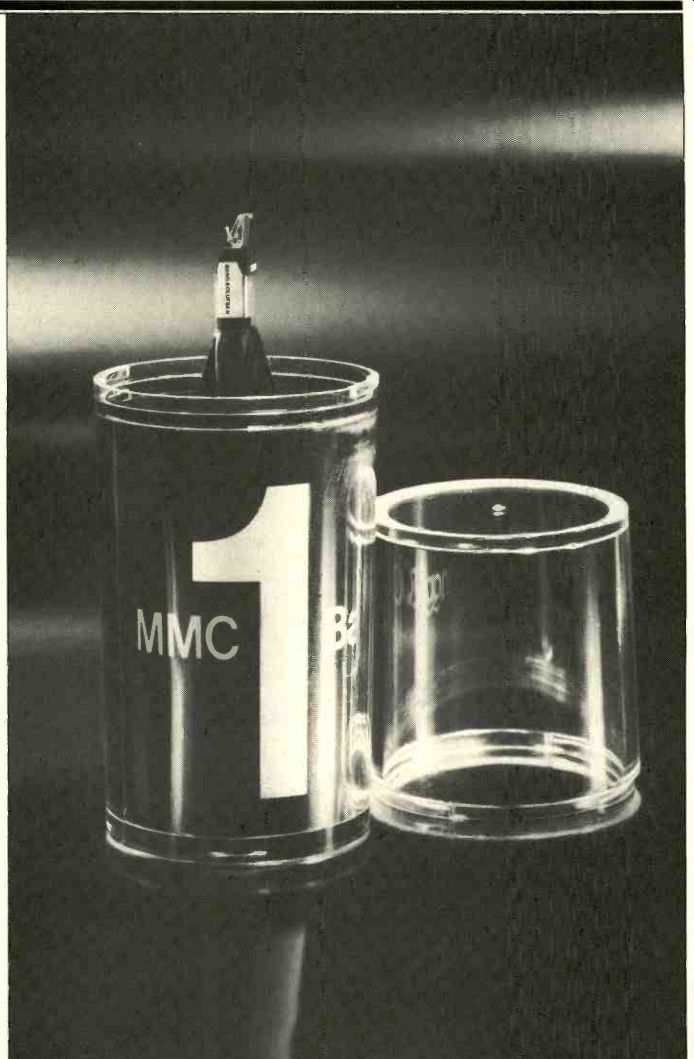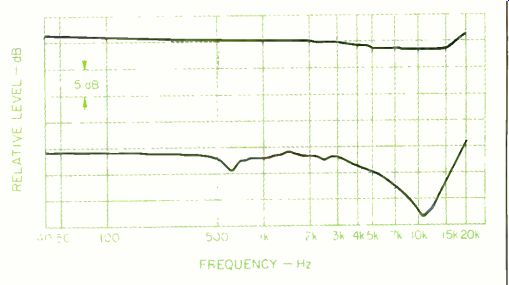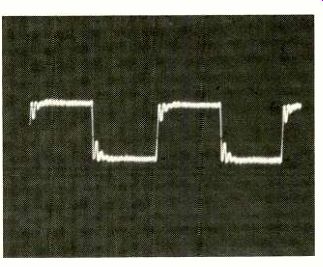
Manufacturer's Specifications
Type: Moving iron.
Stylus: Contact line, nude diamond, 0.1-mm square.
Radius of Curvature: Contact line.
Cantilever: Single-crystal sapphire tube.
Recommended Tracking Force: 1 gram.
Effective Tip Mass: 0.25 mg.
Compliance: 30 x 10^-6 cm/dyne.
Frequency Response: 20 Hz to 20 kHz,-± 1 dB.
Channel Separation: Greater than 30 dB at 1 kHz, greater than 22 dB from 50 Hz to 15 kHz.
Channel Difference: Less than 1 dB.
Output Voltage: Greater than 0.6 mV/cm/S; greater than 2.12 mV/5 cm/S lateral rms.
Recommended Load Resistance: 47 kilohms, minimum.
Recommended Load Capacitance: 400 pF, maximum.
Price: $445.00.
Company Address: 515 Busse Rd., Elk Grove Village, Ill. 60007.
Bang & Olufsen (B & 0) has recently introduced a new series of five phono cartridges, and the MMC 1 is the top of the line. They also seem to have refined their well-established moving-iron generating principle, called the "moving micro-cross" (MMC), which transforms mechanical energy to electrical energy. The X-shaped moving micro-cross armature moves within the magnetic field created by the samarium-cobalt ring magnet. The signal voltage is generated in the high-output, low-impedance coils surrounding the pole pieces. The entire magnetic circuit is enclosed in a Permalloy body shell. The single-crystal, hollow-tube, sapphire cantilever is claimed to be five times stiffer than aluminum and 40% stiffer than beryllium. Further the velocity of sound in the single-crystal sapphire is twice that in aluminum, reducing any phase distortions at high frequencies. The contact-line, diamond-stylus shank is 0.1-mm square and nude-mounted on the sapphire tube cantilever. The effective tip mass is reported to be 0.25 mg.
The physical appearance of the MMC 1 is not much different from its illustrious predecessors. I continue to be impressed by the fact that the entire generating system, with its relatively high output voltage, fits into a body that measures approximately 6-mm square and 12-mm long. The MMC 1 was designed primarily as a plug-in cartridge to fit the B & 0 tangential tonearms. However, a mounting bracet is supplied so that the cartridge can be fitted with any modern tonearm which has half-inch-spaced mounting centers. The MMC 1 is then inserted into the adaptor. The cartridge weighs 1.6 grams and the mounting bracket 1.7 grams, for a total of 3.3 grams. This is certainly one of the lightest cartridges I have ever tested.
The MMC 1 has an attached, hinged stylus guard to protect the stylus while handling the phono cartridge. The stylus is not user replaceable. The cartridge comes with a small stylus cleaning brush and an extra weight for tone-arms requiring a heavier cartridge. Each cartridge comes with its own frequency-response curve and a computer-generated printout showing its output voltage, balance, tracking ability, separation, and 20-kHz output level.
Because of its low-impedance coils, the MMC 1, unlike most phono cartridges, does not have stringent loading needs. The usual 47-kilohm resistive load paralleled by a maximum of 400-pF capacitance is most satisfactory.
Measurements
The B & O MMC 1 phono cartridge was mounted in a Technics headshell and used with the Technics EPA-A250 (S-shape) interchangeable tonearm unit attached to the Technics EPA-500 tonearm base, which was mounted on a Technics SP-10 Mk II turntable. The cartridge was oriented in the headshell and tonearm with the Dennesen Geometric Soundtracktor.
Laboratory tests were conducted at an ambient tempera ture of 70° F (21.11° C) and a relative humidity of 72%, ±3%. The manufacturer's recommended stylus tracking force of 1.0 gram was not sufficient when tracking the higher velocities. It was necessary to increase the tracking force to 1.2 grams, with an anti-skating force of 1.4 grams. The load resistance was 47 kilohms, and the load capacitance was 250 pF.

Fig. 1--Frequency response and separation.

Fig. 2--Response to a 1-kHz square wave.
As is my practice, measurements are made on both channels, but only the left channel is reported unless there is a significant difference between channels, in which case both channels are reported for a given measurement.
The following test records were used in making the reported measurements: Columbia STR-100 and STR-112; Shure TTR-103, TTR-109, TTR-110, TTR-115 and TTR-117; Deutsches HiFi No. 2; B & K OR-2010, and Ortofon 0002.
Frequency response, using the Columbia STR-100 test record (Fig. 1), was + 1, -1.75 dB from 40 Hz to 20 kHz.
Below 1 kHz there was a gradual descent of the response curve starting at about 2 kHz, with a -1 dB level at 4 kHz, -1.5 dB at 5 kHz, -1.75 dB from 8 to 14 kHz, and then rising to + 1 dB at 20 kHz. Separation was 22.25 dB at 5 kHz, 30.5 dB at 10 kHz, 26.5 dB at 14 kHz, and 20 dB at 20 kHz. These data indicate that the B & 0 MMC 1 phono cartridge has a relatively flat frequency response and a good high-frequency separation. The 1-kHz square-wave response, Fig. 2, was relatively flat, with a single well-damped overshoot followed by a very low ringing. After the arm's anti-resonance unit was disabled, the arm-cartridge lateral low-frequency resonance of the left channel was found to be 7.5 Hz at +6 dB; the right channel was also 7.5 Hz, but at +8 dB. Vertical resonance was measured at 9.5 Hz. The high-frequency resonant point was at 34 kHz.
Using the Dynamic Sound Devices DMA-1 Dynamic Mass Analyzer, the arm-cartridge dynamic mass was measured as 18 grams and the dynamic vertical compliance as 15.5 x 10-6 cm/dyne at the vertical resonant frequency of 9.5 Hz. The harmonic distortion components of the 1-kHz, 3.54 cm/S rms 45° velocity signal from the Columbia STR-100 are: 1.58% second harmonic and 0.25% third harmonic, with less than 0.25% higher order terms.
The vertical stylus angle measured 26°, using the Vertical Tracking Angle Meter (Inclination Meter), Model 3002, developed by the CBS Technology Center.
Other measured data are: Wt., 1.6 g, adaptor, 1.7 g, for a total cartridge weight of 3.3 g; opt. tracking force, 1.2 g; opt. anti-skating force, 1.4 g; output, 0.76 mV/cm/S; IM distortion (4:1): +9 dB lateral, 200/4000 Hz, 2.3%, +6 dB vertical, 200/4000 Hz, 5.0%; crosstalk (using Shure TTR-109), left:-27 dB, right:-23 dB; channel balance, 0.2 dB; trackability: high freq. (10.8 kHz, pulsed), 30 cm/S, mid-freq. (1000 and 1500 Hz, lat. cut), 31.5 cm/S, low freq. (400 and 4000 Hz, lat. cut), 24 cm/S; Deutsches HiFi No. 2, 300-Hz test band was tracked cleanly to 86 microns (0.0086 cm) lateral at 16.2 cm/S at +9.66 dB and 55.4 microns (0.00554 cm) vertical at 10.32 cm/S at + 5.86 dB.
The MMC 1 phono cartridge played all the test bands cleanly on the Shure Audio Obstacle Course Era III musical test record. On the Shure Audio Obstacle Course Era IV, the cartridge encountered some difficulty in playing the highest level of the flute, harp and flute, and flute and orchestral bells test bands. The MMC 1 responded very well inasmuch as level 5 peak recorded velocities, particularly in the combined instruments, exceeds 45 and 50 cm/S, respectively.
Generally, commercial records seldom exceed 15 cm/S peak recorded velocity. The Shure Audio Obstacle Course Era V test record was tracked without difficulty at all test bands.
Use and Listening Tests
More than 15 hours of listening was devoted to the musical evaluation of the MMC 1 using the following equipment:
Technics SP-10 Mk 11 turntable, Technics EPA-500 tonearm base fitted with a Technics EPA-A250 (S-shape) inter changeable arm unit, Crown IC-150 preamplifier, Audire DM-700 power amplifier, a pair of Pentagram P-10 full-range loudspeakers, and he Audio-Technica AT666EX vacuum disc stabilizer. The 4PR Kimber Kable was used to connect the power amplifier to the speakers.
In the listening evaluation of the B & 0 MMC 1, 1 found the sound to be neutral in performance, not unlike its predecessor, imparting neither sound nor coloration of its own to the music. Sonic clarity was very good, and the bass was well defined. Tracking ability, transient response, and transparency of sound were very good. I noted that the MMC 1 appeared to favor the human voice, particularly that of the soprano and tenor. Some exceptionally good records I used to audition the MMC 1 were Stravinsky's The Rite of Spring (Philadelphia, Muti, Mobile Fidelity MFSL 1-519), San Francisco Swing Express (Sonic Arts Corporation LS-30), Symphonie Fantastique by Berlioz (Cleveland, Maazel, Telarc DG 10076), and Joe Marino Plays 28 All-Time Greatest Hits, Vol. 1 (RealTime Records RT-302).
The Bang & Olufsen MMC 1, the newly introduced top model in B & O's phono cartridge series, is an excellent performer, with good sound, fine tracking ability, and impressive engineering.
-B. V. Pisha
(Audio magazine, Aug. 1983)
Also see:
B & O MMC 20CL Phono Cartridge (Equip. Profile, Mar. 1980)
B&O 15° High Compliance Stereo Pickup, Model SP 12
= = = =